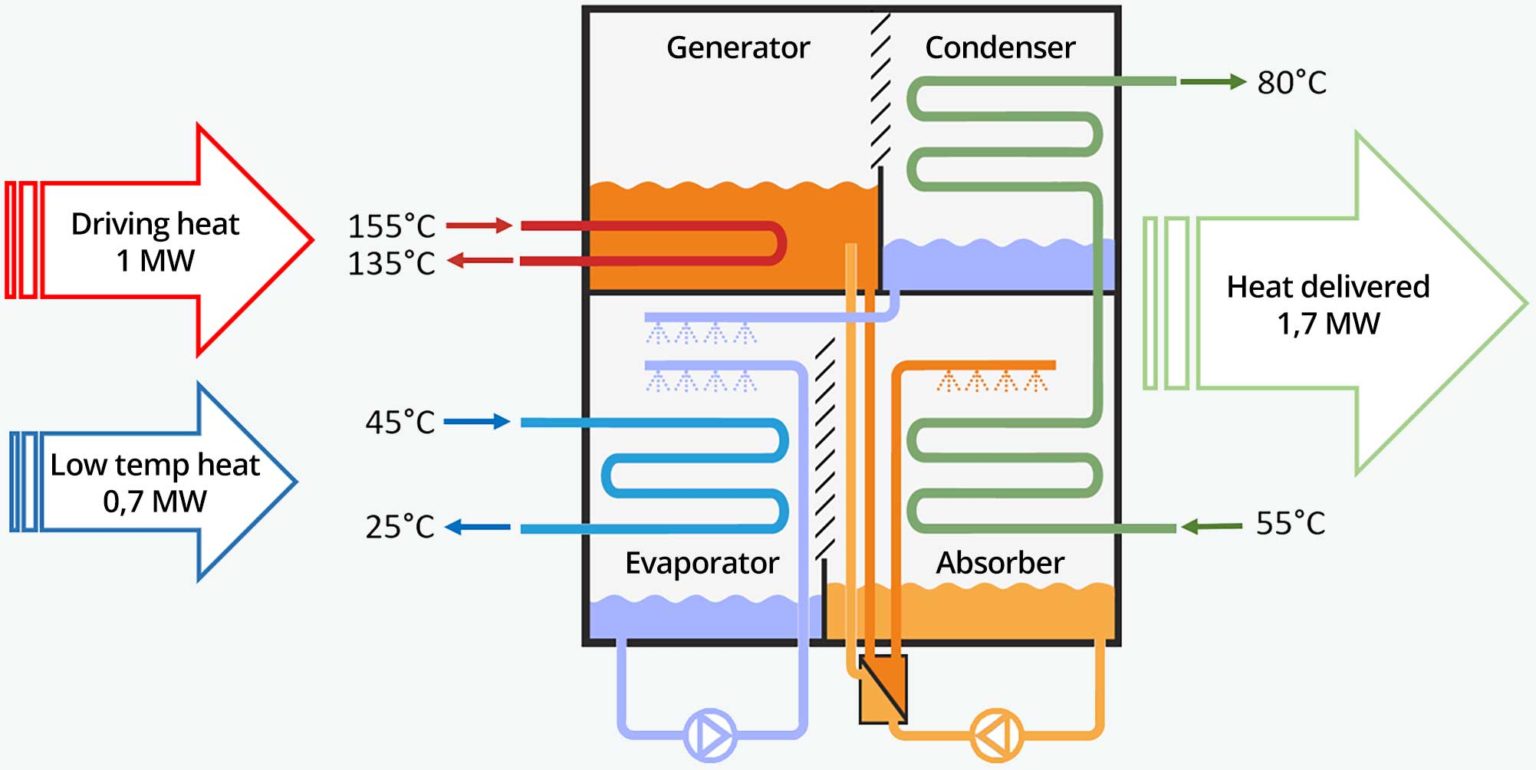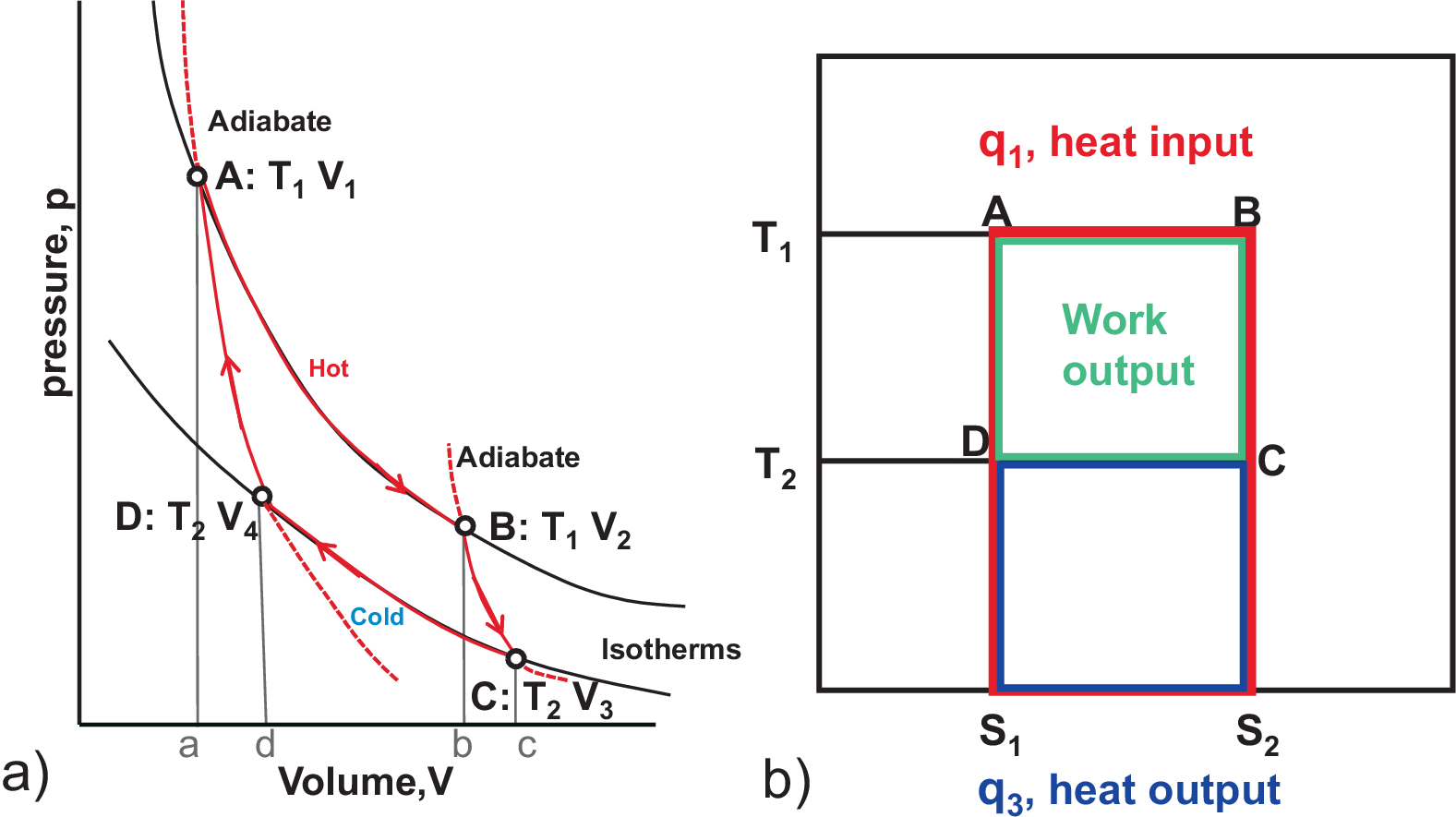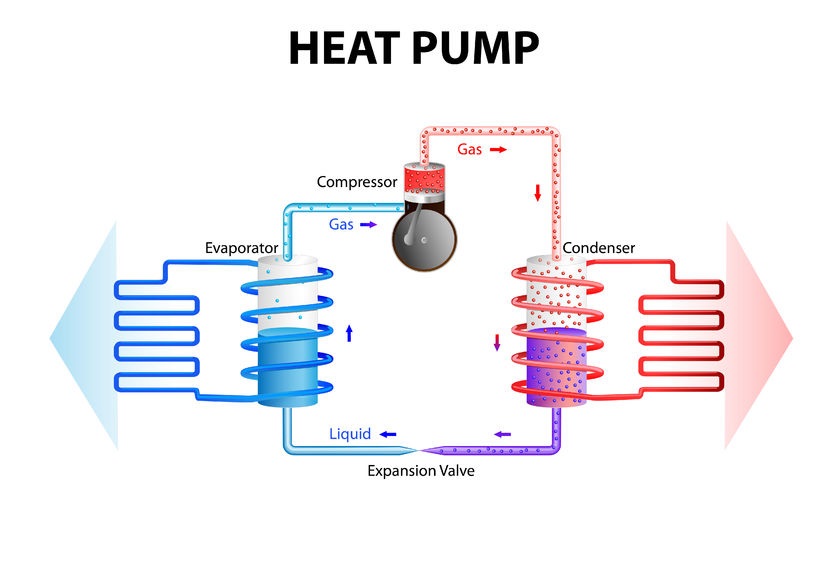Heat pump efficiency_ A heat pump is a machine to warm and cools buildings by transferring the thermal energy of cooler space to a warmer area using the various types of refrigeration cycles. It is the reverse direction in which heat transfer occurs without external power. Conventional heat pump types include ground source heat pumps, air-source heat pumps, water source heat pumps, and exhaust air heat pumps. They can also often be installed in district heating systems.
The efficiency of a heat pump is shown by a coefficient of performance (COP), or the seasonal coefficient of performance (SCOP). Higher values present a more efficient heat pump and indicate that it consumes less energy. These devices are typically much more energy-efficient than simple electrical resistance heaters when used for space heating. Heat pumps have a less carbon footprint compared to heating systems burning fossil fuels such as natural gas and oil.
⇒ View a Comprehensive List of Heat Pumps for Sale and Their Suppliers ⇐
Energy Efficiency and Operation Cost
In fairly cold outdoor temperatures, heat pump operations provide energy-efficient heating just by using electricity. In these situations, they can be less expensive to operate compared to systems that use more costly heating fuel sources such as oil, natural gas, or propane. As the temperature falls below freezing, the heat pump needs more energy to maintain comfort indoors, and as a result, efficiency reduces and increases electric bills.
We can solve this charge by pairing a heat pump with a furnace and building a hybrid heat system. However, a hybrid system may be more expensive than a more ordinarily paired air conditioner and furnace system because of the higher initial expense for the heat pump unit.
Both air conditioners and heat pumps come in models with high SEER (seasonal energy efficiency ratio) ratings in cooling mode, providing energy-efficient cooling during the hot summer months. SEER ratings for heat pumps are similar to miles-per-gallon for a vehicle. It gives you a standard measure for understanding efficiency so you can evaluate different models. Higher SEER heat pumps are more efficient units. In heating mode, heat pump performance is expressed in HSPF (Heating Seasonal Performance Factor).
The higher HSPF heat pumps have higher efficiency. In many ways, the energy efficiency and price of operating factors are based on the location. In regions with moderate temperatures, a heat pump is a more suitable option for efficient heating than in areas with freezing winters. If you want a higher heat pump efficiency, be sure to select hybrid ones.

What is Heat Pump Efficiency?
An Air Source Heat Pump (ASHP) typically produces about 3kW thermal energy for every 1kW of electrical power consumed, providing an effective “efficiency” of 300%. It is thermodynamically impossible to have more than 100% efficiency, as this indicates that more energy is being generated than is being put in. As a reason, the performance is displayed as a Coefficient of Performance (COP) instead of efficiency. The case above would be represented as having a COP of 3.
It appears that more energy is being provided than is consumed because the only “valuable” input energy is electricity used to run the compressor and circulating pumps. The rest of the energy transferred from a heat source that would otherwise not be utilized (such as the ground, ambient air, or a river) is not considered an energy input.
While the title Coefficient of Performance is usually used, it is essential to understand the differences and to be able to compare different types that might be using other measures.
- Seasonal Coefficient of Performance _ Used principally with ASHPs to measure heat pump performance in a year, accounting for varying air temperatures. We have three climatic zones set across Europe, defined in BSEN14825.
- Seasonal Energy Efficiency Ratio (SEER)_ Used principally with ASHPs to measure heat pump cooling performance in a year, accounting for varying air temperatures. We have three climatic zones set across Europe, defined in BSEN14825.
- Energy Efficiency Ratio (EER)_ It is a measure of the ratio of given thermal power to total electrical energy. Electrical energy includes ancillaries such as all the pumps, fans, and controls.
- Seasonal Performance Factor (SPF)_ It gives a measure of the ratio of produced thermal energy over the year to total electrical consumption.
Equipment Efficiency
Among other forms of “renewable” energy, where the fuel source is virtually unlimited and free, it is the total cost of production rather than the efficiency that matters.
For comparison, other kinds of heat generation have the subsequent efficiencies:
- Conventional gas/oil boiler: 70-80% efficiency
- Condensing gas/oil boiler: 90-96% efficiency
- Direct electric heating: 35-45% efficiency (with losses in generation and distribution).
With the increase in temperature difference between output and input, the compressor pressure is required to power it; therefore, the COP decreases. Consequently, it is vital to understand the temperature at which it is measured and the range over which it will work.
Developments in Heat Pump Efficiency
We can observe a general trend towards developing more compact, higher efficiency devices, which will decrease the capital and operating costs.
Absorption heat pumps (GAHP) consume either natural gas or waste heat to avoid refrigerant gases. These operate similarly to absorption chillers; however, COP would be in the range of 1.4 to 1.7 compared to higher COP in electric heat pumps. They can deliver higher temperatures and can be connected to a gas source, offering an excellent retrofitting option in particular to older buildings with a current hydronic gas-fired central heating system that works at higher temperatures compared to other heat pump technology.
The market GAHP’s are currently geared up for small and medium-sized commercial end-users (offices, schools, hotels) with system capacity ranging in 35-40kW heat output with more considerable demands being met managing multiple units.
We have mature absorption technology, but the market for GAHP’s in Europe is not entirely developed, with perhaps only 45,000 units established to date by a few suppliers. However, GAHP and heat systems are predicted to be critical applications in the challenge of reaching emissions reduction targets and energy requirements as far as 2050. GAHP’s will play a significant role in the supply of heat in buildings.

Other enhancements that will improve the uptake and effectiveness of heat pumps are:
- Installing highly efficient compressors_ centrifugal compressors are the most suitable ones when the load is steady and near the maximum rating. In contrast, scroll compressors are most helpful when the load is unsteady.
- Compression systems for natural working fluids – not using Fluorinated gases, which may have Ozone destructive effects or global warming potential.
- Thermal stores_ allow operation during cheaper nighttime rate periods and store the energy for daytime use. This also helps to reduce heat pump cycling.
Heat Pumps Thermodynamic Cycle
Thermodynamic refrigeration cycles or heat pump cycles are mathematical and conceptual models for air conditioning, refrigeration systems, and heat pumps. A heat pump is a mechanical device that permits the transmission of heat from one point (source) at a lower temperature to another point (sink or heat sink) at a higher temperature.
A heat pump may be considered as a heater if the purpose is to warm the heat sink (warming the interior of a house on a cold day), or a cooler or refrigerator if the purpose is to cool the heat source (the normal operation of a freezer). In both cases, the running principles are close. Heat is transferred from a cold spot to a warm spot.
Based on the second law of thermodynamics, heat can not automatically flow from a colder place to a hotter space, and work is needed to achieve this. An air conditioner requires energy to cool an existing space, moving heat from the cooler inside (the heat source) to the warmer outdoors (the heat sink).
Likewise, a refrigerator removes heat from the inner cold icebox (the heat source) to the more temperate air of the kitchen (the heat sink). The working principle of the ideal heat engine was defined mathematically using the Carnot cycle by Sadi Carnot in 1824. An ideal heat pump or refrigeration system can be considered an ideal heat engine if it is operating in a reversed Carnot cycle.
Heat pump and refrigeration cycles can be categorized as vapor absorption, vapor compression, gas cycle, or Stirling cycle types.
Reversed Carnot cycle
We can work with the Carnot cycle in a reversible direction so the four processes that hold it (two isentropic and two isothermal) can also be reversed. When a Carnot cycle operates reversely, it is named a reversed Carnot cycle. A heat pump or refrigerator that works on the reversed Carnot cycle is known as a Carnot heat pump or Carnot refrigerator, respectively. In the first process of this cycle, the refrigerant receives heat isothermally from a low-temperature source, TL, with the amount of QL.
Next, the refrigerant is compressed in an isentropic process, and its temperature grows to that of the high-temperature source, TH. When at this high temperature, the refrigerant releases the amount of QH heat isothermally. Also, during this step in the condenser, the refrigerant turns into a saturated liquid from a saturated vapor. Finally, the refrigerant expands in an isentropic process until its temperature drops to that of the low-temperature source, TL.

Equations For Heat Pump Efficiency
As discussed before the refrigerator or heat pump efficiency is given by a parameter known as the coefficient of performance (COP).
The COP equation is:
COP=\frac{Q}{W}
Where:
- Q is the total heat supplied or removed by the system.
- W is the work needed by the considered approach.
The following equation gives the Detailed COP of a refrigerator:
COP_{R}= \frac{Q_L}{W_(net,in) } = \frac{ output}{ input}= \frac{cooling}{ input}
The COP of a heat pump (in some cases referred to as the coefficient of amplification COA), presented by the following equation, as we know that QH = QL + Wnet, in:
COP_{HP}=\frac{Q_H}{W_(net,in) }=1+\frac{Q_L}{W_(net,in) }=\frac{output}{input}=\frac{heating}{input}
Both the COP of a heat pump and a refrigerator can be larger than one. Combining these two equations for fixed values of QH and QL ends in:
COP_{HP}=COP_{R}+1
This means that COPHP will be higher than one because COPR will be a non-negative quantity. In a worst-case situation, the heat pump will provide as much energy as it consumes, making it a resistance heater. However, in-home heating, some of QH is wasted on the outside air through insulation, piping, etc., thus making the COPHP fall below unity when the outdoor air temperature is too low. Consequently, the system used to heat houses utilizes fuel.
Carnot heat pumps efficiency (COP) can be displayed in terms of temperatures:
COP_{R,carnot}=\frac{T_L}{T_H-/T_L} =\frac{1}{\frac{T_H}{T_L}-1}
COP_{HP,carnot}= \frac{T_H}{T_H-/T_L} =\frac{1}{1-\frac{T_H}{T_L}}
Buy Equipment or Ask for a Service
By using Linquip RFQ Service, you can expect to receive quotations from various suppliers across multiple industries and regions.
Click Here to Request a Quotation From Suppliers and Service Providers
Read More on Linquip



